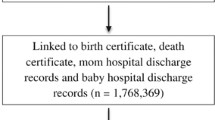Abstract
The objective of the study was to assess if small- and large-for gestational age term infants have greater health care utilization during the first year of life. The sample included 28,215 singleton term infants (37–42 weeks) without major birth defects delivered from 1998 through 2007 and continuously enrolled at Kaiser Permanente Northwest for 12 months after delivery. Birth weight for gestational age was categorized into 3 levels: <10th percentile (SGA), 10–90th percentile (AGA), >90th percentile (LGA). Length of delivery hospitalization, re-hospitalizations and sick/emergency room visits were obtained from electronic records. Logistic regression models estimated associations between birth weight category and re-hospitalization. Generalized linear models estimated adjusted mean number of sick/emergency visits. Among term infants, 6.2 % were SGA and 13.9 % were LGA. Of infants born by cesarean section, SGA infants had 2.7 higher odds [95 % 1.9, 3.8] than AGA infants of staying ≥5 nights during the delivery hospitalization; of those born vaginally, SGA infants had 1.5 higher adjusted odds [95 % 1.1, 2.1] of staying ≥4 nights. LGA compared to AGA infants had higher odds of re-hospitalization within 2 weeks of delivery [OR 1.25, 95 % CI 0.99, 1.58] and of a length of stay ≥4 days during that hospitalization [OR 2.6, 95 % CI 1.3, 5.0]. The adjusted mean number of sick/emergency room visits was slightly higher in SGA (7.8) than AGA (7.5) infants (P < .05). Term infants born SGA or LGA had greater health care utilization than their counterparts, although the increase in utilization beyond the initial delivery hospitalization was small.
Similar content being viewed by others
References
Minior, V. K., & Divon, M. Y. (1998). Fetal growth restriction at term: Myth or reality? Obstetrics and Gynecology, 92(1), 57–60.
Zhang, X., Decker, A., Platt, R. W., & Kramer, M. S. (2008). How big is too big? The perinatal consequences of fetal macrosomia. American Journal of Obstetrics and Gynecology, 198(5), 517.e1–517.e6.
Stotland, N. E., Caughey, A. B., Breed, E. M., & Escobar, G. J. (2004). Risk factors and obstetric complications associated with macromia. International Journal of Gynaecology and Obstetrics, 87(3), 220–226.
McIntire, D. D., Bloom, S. L., Casey, B. M., & Leveno, K. J. (1999). Birthweight in relation to morbidity and mortality among newborn infants. New England Journal of Medicine, 340(16), 1234–1238.
Seeds, J. W., & Peng, J. (1998). Impaired growth and risk of fetal death: Is the tenth percentile the appropriate standard? American Journal of Obstetrics and Gynecology, 178, 658–669.
Hornbrook, M. C., Whitlock, E. P., Berg, C. J., et al. (2006). Development of an algorithm to identify pregnancy episodes in an integrated health care delivery system. Health Services Research, 42, 908–927.
Callaghan, W. M., & Dietz, P. M. (2010). Differences in birth weight for gestational age distributions according to the measures used to assign gestational age. American Journal of Epidemiology, 171(7), 826–836.
Maisels, M. S., & Kring, E. A. (1998). Length of stay, jaundice, and hospital readmission. Pediatrics, 101, 995–998.
Qiu, X., Lodha, A., Shah, P. S., Sankaran, K., Seshia, M. M., Yee, W., et al. (2012). Canadian Neonatal Network. Neonatal outcomes for small for gestational age preterm infants in Canada. American Journal of Perinatology, 29(2), 87–94.
Luu, T. M., Lefebvre, F., Riley, P., & Infante-Rivard, C. (2010). Continuing utilisation of specialised health services in extremely preterm infants. Archives of Disease in Childhood. Fetal and Neonatal Edition, 95(5), F320–F325.
Bird, T. M., Bronstein, J. M., Hall, R. W., Lowery, C. L., Nugent, R., & Mays, G. P. (2010). Late preterm infants: birth outcomes and health care utilization in the first year. Pediatrics, 126(2), e311–e319.
Acknowledgments
The findings and conclusions in this article are those of the authors and do not necessarily represent the official position of the Centers for Disease Control and Prevention or Kaiser Permanente.
Author information
Authors and Affiliations
Corresponding author
Rights and permissions
About this article
Cite this article
Dietz, P.M., Rizzo, J.H., England, L.J. et al. Health Care Utilization in the First Year of Life among Small- and Large- for-Gestational Age Term Infants. Matern Child Health J 17, 1016–1024 (2013). https://doi.org/10.1007/s10995-012-1082-z
Published:
Issue Date:
DOI: https://doi.org/10.1007/s10995-012-1082-z




